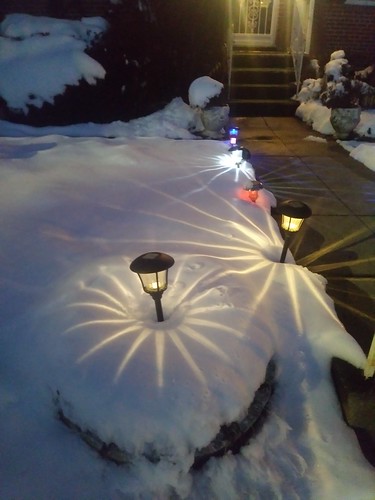Snow, winter and the "Sustainable Mobility City"
After a major set of snowstorms in 2010, I started writing an annual piece on what I called "a maintenance of way agenda for the transit city."
-- "A "maintenance of way" agenda for the walking and transit city," 2010
-- "Snow reminds us of the necessity of a "maintenance of way" agenda," 2013
-- "Testimony on the Winter Sidewalk Safety Amendment Act of 2011," 2011
-- "Level of service and maintenance requirements in planning #2: winter maintenance of bike paths," 2012
-- "Night-time safety: rethinking lighting in the context of a walking community," 2014
-- "Planning for Winter Weather," 2015
-- "Cataloging the various failures to remove snow in the walking/transit/bicycling city," 2015
-- "Who knew?: there is a Winter Cycling Federation and annual conference," 2015 -- the upcoming Congress is in Montreal, February 8th-10th, 2017
-- "Focusing on what's most important: snow on sidewalks or snow on cars?," 2016
-- "Winter preparedness, planning and the Walking/Biking/Transit City," 2019
-- "Walking City Wintertime: Snow and strollers in Toronto," 2019
 MOW is a term used by railroads. And "transit city" encompasses sustainable modes of transportation--walking, biking, and transit--based on the concepts expressed in "Transportation and Urban Form" by Peter Muller.
MOW is a term used by railroads. And "transit city" encompasses sustainable modes of transportation--walking, biking, and transit--based on the concepts expressed in "Transportation and Urban Form" by Peter Muller.Cities still are grappling with reorienting practices of city agencies in favor of sustainable mobility, even though a majority of transportation movement in cities is likely to be by pedestrians and transit riders.
One of my indicators in change in practice was how the Takoma Recreation Center has slowly expanded its sidewalk snow removal practices over the years, something that I tend to comment on in the series of pieces. Over ten years, now they pretty much remove snow from all the sidewalk around four blocks, which is quite good since originally they did zero clearance from the perimeter sidewalks.
I was really surprised to see the DC DPW director, in this piece the other day from WTOP-radio, "How DC is preparing for this year’s wintry ‘Polar Coaster’," acknowledge as a priority snow clearance from bike lanes, intersections, and bridges, which have been persistent problems over the decades as the snow plow practice "regime" preferences motor vehicle movement. From the article:
“Protecting bike lanes has become a higher priority as more residents use bicycles as an alternative and even primary mode of transportation. The snow teams … are dedicated to keeping the bike paths, bridge deck, sidewalks, [disabled accessible] ramps, intersections and bus shelters clear,” Geldart said.The article includes a twitter message embed with a video demonstrating a smaller machine used for clearing bike lanes.
 And I have noticed, just like with the Takoma Recreation Center, incremental improvements over the years.
And I have noticed, just like with the Takoma Recreation Center, incremental improvements over the years.E.g., last Janruary I was shocked to see DPW crews salting sidewalks on bridges across North Capitol Street in advance of a snow storm when I was at a meeting in the Bloomingdale neighborhood.
While these are great steps there are always opportunity for improvement.
Past pieces have discussed better practice such as:
- how Rochester, New York takes the responsibility for clearing snow from all the city's sidewalks
- how the Minneapolis Bicycle Master Plan has an element on maintenance including winter snow clearance
- how Holland, Michigan created a system of steam/water pipes under downtown sidewalks to melt snow as it falls
- Montreal's clearance of snow from a defined winter network of cycle paths, and how some trails, such as the Minuteman Trail in Suburban Boston, the Capital Crescent Trail in Bethesda, and DC's Metropolitan Branch Trail have snow clearance protocols
- a Winter Cycling Federation links cities across the Northern Hemisphere on snow clearance and bicycling matters
- The second Friday of February is International Winter Bike to Work Day, which Minneapolis recognizes
- and Toronto is grappling with implementing snow clearance from sidewalks in the core ("Toronto’s snow divide: Why the city might plow your neighbour’s sidewalks, but not yours" and "Despite last winter’s plowing problems, Toronto council brushes off snow-clearing debate," Toronto Star. There is a report on the matter ("Clearing snow from downtown sidewalks is apparently harder than it looks," Toronto.com), but I haven't been able to track it down. Ironically, the city clears snow outside the core, but not in the core which is dominated by pedestrian activity.
Labels: car culture and automobility, disability planning, emergency management planning, nightlife economy, pedestrian safety, public space management, snow removal, transportation planning, urban design/placemaking



1 Comments:
https://www.thestar.com/opinion/star-columnists/2022/01/25/toronto-has-removed-thousands-of-tonnes-of-snow-from-city-streets-in-the-past-week-then-why-are-sidewalks-still-so-dangerous.html
"Toronto has removed thousands of tonnes of snow from city streets in the past week. Then why are sidewalks still so dangerous?"
Post a Comment
<< Home